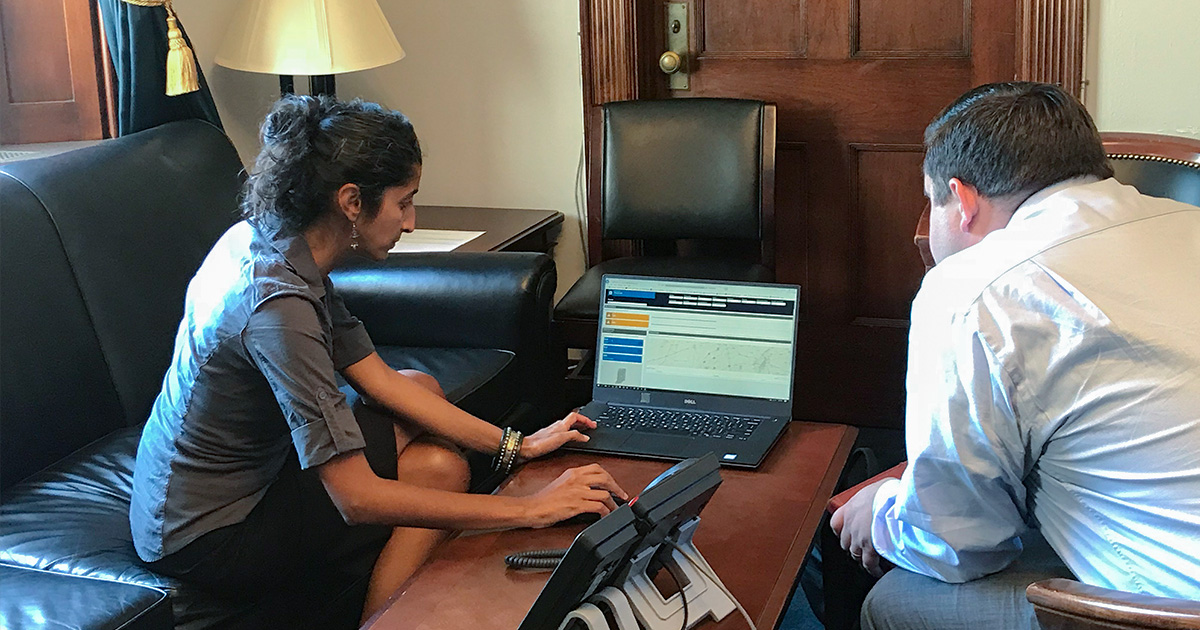Imagine you’ve spent the last five years of your professional life measuring the impacts of a program designed to help people with limited work experience. Imagine you’ve uncovered evidence that it actually worked! More people are finding work, and more people are earning a family-sustaining wage. Wouldn’t you want policymakers to know about this program and the evidence you uncovered? Wouldn’t you want the very people who are crafting workforce policy and funding training programs to understand what you’ve learned when they are deciding how to better help people find jobs?
Unfortunately, as much as the evidence-based policy community has grown and evolved in the last few decades, many of the approaches to getting this evidence in front of the people who need it most haven’t changed. At Mathematica, we’re helping our partners reimagine not only the way the world gathers and uses information but also the way we share it, and that includes helping experts champion their own work.
We can’t expect policymakers, program administrators, and practitioners to stumble upon new evidence (let alone slog their way through multiple field-specific academic journals). As an evidence community, we have to do more to show them the way. These 10 tips, organized by how much time you’ll need, can help you get started.
What can I do in one hour?
- Send a personal email (with a link to your work) to at least 15 contacts. This list should include former colleagues, peers, mentors, industry professionals, practitioners, clients, and other people who are most likely to care about your work. Ideally, these contacts will forward your message to contacts of their own, and so on. They might already be familiar with the study, but don’t let that deter you. People are more likely to open an email from someone they know, and multiple reminders underscore the importance of your study to the broader policy community.
- Post links on social media. To get the most out of your social networks, take a minute to craft short and meaningful digital content on your personal Instagram, Facebook, LinkedIn, and Twitter feeds. Include photos, graphics, and a link to your study. Be sure to tag study coauthors or funders, and check to see if there are one or two relevant hashtags that you can use to expand your reach by tapping into existing online conversations. First-time social media users should consult their organization’s social media guidelines before mentioning their work on personal social media feeds. Encourage your followers to share and like your content by personalizing the story.
- Link to your study in your email signature. Remember to update your email signature as more resources become available (that is, add any relevant news coverage or related events). For example, update your email signature with the following: “I’ve coauthored a new study about charter schools. Ask me all about it!”
- Identify opportunities for cross-promotion. Consider the newsletters or online publications you read each day. Perhaps there’s an opportunity to connect with these resources to cross-promote your work. Is your report likely to pique the interest of groups like the National Academy for State Health Policy? If so, connect with them directly! They might be open to sharing your content among their networks, thereby directly extending your work’s reach.
- Do a podcast interview. Since launching just one year ago, listeners have played Mathematica’s On the Evidence podcast hosted by J.B. Wogan more than 20,000 times. Podcasts often represent multiple points of view and offer multiple points of entry to a topic, and they help translate complex data into action-oriented evidence in a way that can be useful for policymakers, practitioners, and other decision makers. To meet listeners’ needs, they are usually available via SoundCloud, Spotify, Stitcher, and Apple Podcasts. Other popular podcasts to consider contacting include Planet Money, hosted by NPR, and The Impact, run by Vox news. New issue-specific podcasts are launching all the time.
- Brainstorm and pitch collaborative conference presentations. Beyond the typical research conferences that might not extend your reach further than your peers, explore opportunities to present with colleagues and external partners at gatherings such as the Aspen Ideas Festival, Health Datapalooza, South by Southwest, American Public Human Services Association conferences, the Carnegie Foundation Summit on Improvement in Education, or other similar events. Many of these conferences place a premium on collaborative presentations that bring together multiple viewpoints and perspectives, so think about how you can engage your funding partners, client sites, and program participants. Compelling conference presentations can introduce new audiences to your work.
- Be present. Attend topical panel discussions, roundtable meetings, or congressional briefings hosted by organizations with an interest in the policy topic you study. For example, events hosted by the Brookings Institution, the Center for American Progress, American Enterprise Institute, Bipartisan Policy Center, the Center for Law and Social Policy, the Data Coalition, and the Alliance for Health Policy can reach policymaker audiences. Face-to-face engagement with stakeholders offers you visibility as a subject-matter expert, potentially leading to a seat on the panel at future events.
- Write a blog post. Distilling your work into a short post helps provide evidence-based insights about timely and important policies and offers an entry point for nontechnical audiences to better understand relevant emerging trends. Many blogs, including this one, accept guest commentary. Work with your Communications department to seek out these opportunities—and be sure to credit your coauthors when appropriate. Consider pitching your ideas to the Brookings Institution Brown Center Chalkboard blog, The Hill’s Congress Blog, the Health Affairs Blog, and others that cater to the audience you’re trying to reach.
- Pitch yourself to media. Journalists who report on social policy topics and data-driven decision making aren’t likely to cover the ins and outs of your specific report (no matter how timely and relevant), but these same writers are constantly in need of subject-matter experts to provide accessible information and insights. Work with your Communications department to build relationships with these journalists and editors by participating in media interviews. Highlight the impact of your work as it relates to ongoing policy discussion or programmatic decision making. Remember that you are there to highlight key findings that draw attention to the larger study.
- Apply for awards. To broadly extend the reach of your work, consider submitting applications for a variety of communications industry award competitions. Within the communications world, awards like the Public Relations Society of America Silver Anvil Awards, the International Association of Business Communicators Gold Quill Awards, the Hermes Creative Awards, or others can go a long way to extending your reach to new audiences. Your Communications department can help you identify opportunities and put together an entry that is primed for a win.
What can I do over the course of an afternoon?
I have extra time this week. What more can I do?
For more examples of how Mathematica’s experts champion their work (and how you can too), follow us on Twitter, Instagram, Facebook, and LinkedIn.



